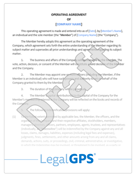Writing Bylaws for Your Nonprofit: A Practical Guide
Bylaws are the backbone of your nonprofit. They provide the rules and structure needed to ensure smooth operation and effective governance. If you're...
7 min read
LegalGPS : Oct. 10, 2024
A conflict of interest policy is an important safeguard for any nonprofit organization. It helps protect the integrity of your organization by ensuring that the interests of its stakeholders are aligned, and it reduces the risk that you might be sued for a breach of fiduciary duty. With so many potential conflicts to consider, however, developing a comprehensive policy can be challenging. The following guide will help you develop a plan to create your own conflict of interest policy.
By the end of this article, we hope you'll be able to implement a bulletproof conflict of interest policy that protects your organization's best interests and promotes transparency.


Protect Against Conflict of Interest!
Legal GPS templates are drafted by top startup attorneys and are fully customizable🛠️.
Trusted by 1000+ businesses to close secure deals.
A conflict of interest policy is a statutory document that every nonprofit should have. This policy outlines how your organization addresses situations where personal interests may conflict with the organization's best interests.
For example, a board member who is also an employee of your organization's biggest vendor may have a conflict of interest if he or she votes on purchases made by the vendor. The goal of this document is to ensure that conflicts are disclosed and addressed before they become problems.
This policy can help your organization ensure both actual and potential conflicts are addressed fairly and transparently, thereby maintaining the trust and support of stakeholders - include donors, volunteers, and beneficiaries. Failure to do so could lead to a loss of donor confidence, damage your reputation and affect the ability to attract new donors. It can also be a violation of IRS rules for nonprofits and put your tax-exempt status at risk.
For example, if a conflict of interest is not disclosed, it could be perceived as a misuse of funds or resources. This would be a violation of IRS rules for nonprofits and put your tax-exempt status at risk. In addition, you may also face legal liability if you don't adequately manage conflicts of interest. How to Manage Conflicts of Interest in Your Nonprofit? A good first step is to create a policy that addresses conflicts of interest and clearly defines what constitutes one.
Conflicts of interest aren't always clear cut. They can be financial - for example, when a board member has a significant investment in a vendor firm. They can also be non-financial - say, a board member has a relative applying for a role in the organization.
All of these are important to manage, especially if you have a large board with diverse interests. With that in mind, you should consider the following questions when developing your policy: What is a conflict of interest? How do we identify and manage conflicts of interest? Who has oversight over managing conflicts of interest? What are some examples of conflicts of interest we might encounter in our organization?
Do this sooner than later - The longer you wait to manage conflicts of interest, the harder it will be to do so. If you have a large board with many different interests and connections, you need to start thinking about how to manage them early on in your organization’s life cycle.
Board members should be proactive in disclosing any potential conflicts and should abstain from votes where they have a conflict of interest. This is an important step in the process of managing conflicts of interest. It shows that you are taking the issue seriously and showing your donors and other stakeholders that their interests come first. The board should be able to articulate how it manages conflicts of interest so that it is clear to everyone involved.
For example, board members may have a conflict of interest if they are involved in other organizations that compete with yours for funding. It is important to manage these conflicts by not voting on issues related to them, abstaining from voting when possible, or recusing yourself from the meeting entirely.
Achieve Tax-Exempt Status for Your Nonprofit
An efficient policy should define what constitutes a conflict of interest, establish procedures for managing conflicts, and lay out repercussions for non-compliance. It should also be easy to read, so that people can easily understand what they are and aren’t allowed to do. A well-written policy should be clear about why conflicts of interest are a problem—in other words, what they mean for your organization’s mission.
A conflict of interest could prevent board members from making the most effective decisions possible because they have personal interests at stake.
For example:
If a board member owns shares in a company you’re considering investing in, he might not be able to make an impartial decision about whether to invest.
If a board member has been offered a job with another organization and he hasn’t disclosed this information yet, it could create confusion among the other members about his commitment.
If a board member is a close friend of the CEO, he might be reluctant to challenge the CEO’s ideas during meetings.
If a board member has personal relationships with people who are applying for jobs at your organization, she might not be able to give those applicants fair consideration.
Creating a conflict of interest policy takes careful planning and attention to detail. To ensure your policy effectively manages conflicts and complies with applicable laws, make sure to follow these actionable steps:
When drafting your conflict of interest policy, start by defining who the policy covers. This typically includes board members, key employees, and other decision-makers within your organization. Be sure to establish clear definitions for all roles, as this will make it easier to enforce the policy.
Doing so will also help you avoid disputes over whether a particular individual falls within the scope of coverage. If your organization employs volunteers, consider including them in your policy as well.


Legal GPS Pro
Protect your business with our complete legal subscription service, designed by top startup attorneys.
Next, explain what types of situations may pose a conflict of interest. These may include:
Financial interests: A board member or key employee has a significant investment or stake in a company your nonprofit is looking to do business with.
Personal relationships: A board member or key employee has a family member or close friend who may benefit from your nonprofit's decisions or actions.
Professional ties: A board member or key employee serves in a leadership role for another organization that may compete for resources or collaborate with your nonprofit.
Conflicts of commitment: A board member or key employee has a competing interest that is more important than the work of your nonprofit. For example, they may be working with another organization to fulfill their own personal interests and goals.
Specify how conflicts of interest should be disclosed, both during the initial onboarding process and on an ongoing basis. Include clear instructions for reporting potential conflicts, like filling out a disclosure form or submitting a written statement to the board. If you don't have a written policy for disclosure, you may not be able to prove that the board member was aware of the conflict and should have disclosed it.
For example, if a board member has an interest in a company that is seeking funding from your organization, the board member should disclose this potential conflict of interest. If there's no protocol for disclosing conflicts, the board member may argue that he or she wasn't aware of their obligation to disclose.
Once a conflict is disclosed, it's vital to outline the steps the organization should take. These may include:
Recusal: Require the conflicted individual to remove themselves from any discussions, decision-making, or voting related to the conflict.
Independent review: Have a designated committee or third party (such as legal counsel) review and provide guidance on the best course of action.
Documenting decisions: Ensure all decisions related to the conflict are documented in meeting minutes or other official records, for transparency and future reference.
Get Your Conflict of Interest Policy Template
with a Legal GPS Subscription
Clearly outline the consequences for failing to disclose conflicts or comply with the established procedures. This may include disciplinary action, removal from a position of authority, or even termination, depending on the severity and impact of the conflict.
For example, a member of your board may be given an opportunity to resign or be removed from their position if they have failed to disclose conflicts. In cases where the conflict is severe and has had a major impact on the organization, termination may be warranted.
To keep your conflict of interest policy up to date and effective, schedule regular reviews and updates as necessary. This could be an annual review or more frequent if required by law or your organization's bylaws. Commonly, organizations review their policies every year or two. This helps ensure that the policy is up to date and can be modified as needed.
A policy is only as effective as its implementation. Make sure that everyone covered by the conflict of interest policy receives proper training and fully understands their responsibilities, the potential consequences, and how to take appropriate action if they identify a conflict.
This ensures that your organization is prepared for any situation that may arise. It can also help prevent conflicts from arising in the first place by giving employees the tools to identify and handle them appropriately.
At the end of the policy, include a section where each individual covered by the policy can sign and acknowledge that they have read, understood, and agree to comply with the conflict of interest policy. Keep these acknowledgments on file as part of your organization's records.

Protect Against Conflict of Interest!
Legal GPS templates are drafted by top startup attorneys and are fully customizable🛠️.
Trusted by 1000+ businesses to close secure deals.
Writing a robust conflict of interest policy doesn't have to be a daunting task. Utilizing a well-structured template such as ours can save you time and ensure you cover all the legalities. Click here to learn more about our conflict of interest template.
To secure your nonprofit organization's reputation and integrity, a well-orchestrated conflict of interest should be a top agenda. Our template offers a shortcut to drafting a policy that is legally sound and easy to comprehend and follow.
The biggest question now is, "Do I need a business lawyer?” For most businesses and in most cases, you don't need a lawyer to start your business. Instead, many business owners rely on Legal GPS Pro to help with legal issues.
Legal GPS Pro is your All-In-One Legal Toolkit for Businesses. Developed by top startup attorneys, Pro gives you access to 100+ expertly crafted templates including operating agreements, NDAs, and service agreements, and an interactive platform. All designed to protect your company and set it up for lasting success.
Get Legal GPS's Conflict of Interest Policy Template Now

Legal GPS Pro
Protect your business with our complete legal subscription service, designed by top startup attorneys.
| Premium Template Single-use Template |
Legal GPS Pro Unlimited Access, Best Value |
|
|
| Get Template | Learn More |
| Trusted by 1000+ businesses | |
Table of Contents

Bylaws are the backbone of your nonprofit. They provide the rules and structure needed to ensure smooth operation and effective governance. If you're...

Choosing the right directors and officers for your nonprofit is one of the most crucial decisions you'll make as a founder. The individuals you...

1 min read
Your nonprofit must be established as a member or nonmember nonprofit. And you have to decide that choice when you're drafting your Articles of...